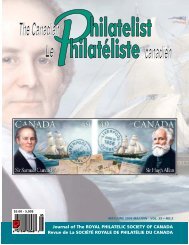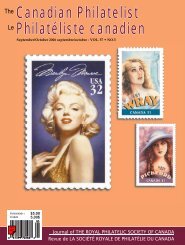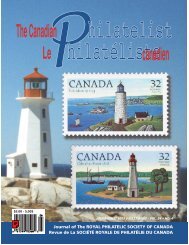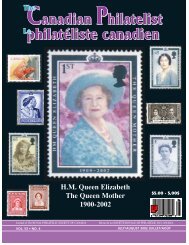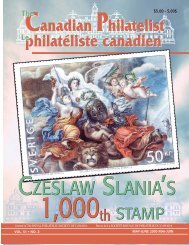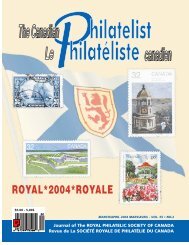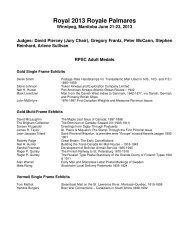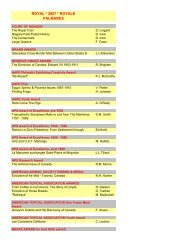GREENWOOD STAMP COMPANY â Since 1962 - The Royal ...
GREENWOOD STAMP COMPANY â Since 1962 - The Royal ...
GREENWOOD STAMP COMPANY â Since 1962 - The Royal ...
Create successful ePaper yourself
Turn your PDF publications into a flip-book with our unique Google optimized e-Paper software.
Transcribing Sounds<br />
by Michael Madesker, RDP, FRPSC<br />
BRAILLE ALPHABET: EDUCATIONAL FACILITIES (part I of III)<br />
A July 28, 1853 folded letter from Rockaway,<br />
L.I., N.Y., paying the 3c rate with an orange/<br />
brown imperforate Washington stamp of the 1851-<br />
56 definitive series is illustrated below. It was<br />
postmarked at Jamaica, N.Y. on July 29. <strong>The</strong> letter<br />
was written by John King of Rockaway and<br />
addressed to <strong>The</strong>odore D. Camp, Superintendent<br />
of the Manufacturing Department of the New<br />
York Institution for the Blind. This school’s Board<br />
of Managers considered it as their mandate to prepare<br />
its pupils to lead an independent life through<br />
teaching them trades in addition to scholastic<br />
subjects appropriate to their age. <strong>The</strong> school was<br />
tuition free.<br />
<strong>The</strong> New York Institution for the Blind was<br />
incorporated in 1831 as a learning establishment.<br />
Its first classes commenced on March 15, 1832 with<br />
three pupils. <strong>The</strong> school’s curriculum was identical<br />
to that of sighted children with the<br />
addition of learning communication skills,<br />
verbal and environmental. Older children<br />
were also taught daily living skills, much<br />
like those in residential schools for the<br />
general population. An innovation, added<br />
later, was preparing the young pupils for<br />
independent living and some skills needed<br />
to earn a living. This grew into a manufacturing<br />
division which included a mattress<br />
production and repair shop. <strong>The</strong> above<br />
letter was an order for a specialty mattress<br />
for an obviously tall person. <strong>The</strong> dimensions<br />
of the mattress are given as 6'3" long,<br />
4'7" wide. It had to have the best white<br />
hair and a palliasse straw mattress, for an<br />
underbed. Palliasse is derived from the Italian<br />
word paglia, straw.<br />
<strong>The</strong> sponsors of the New York Institution for<br />
the Blind in 1870 directed the Board of Managers<br />
to scale down the Manufacturing Department in<br />
favour of greater scholastic training. This was followed<br />
by a court order, 20 years later, in 1896 to<br />
bring the school under the State Board of Charities<br />
based on the fact that neither the pupils nor their<br />
parents or guardians paid towards the upkeep of<br />
the children. <strong>The</strong> Board of Managers, headed by<br />
Superintendent William Bell Wait, took exception<br />
to their children being castigated paupers and filed<br />
an appeal. <strong>The</strong> lower courts reversed the decision<br />
and in 1897 the case was heard in the High Court.<br />
This Court decided that the school, though educational<br />
in character, was indeed dependant on the<br />
charity of the State. <strong>The</strong> Solomonic decision of the<br />
Court was that the Institution would henceforth<br />
come under the aegis of the State Department of<br />
Education with the State Department of Social<br />
Welfare limiting its activities there to providing<br />
physical care.<br />
In 1912 the Board of Regents of the University<br />
of the State of New York, on petition by the<br />
Board of Managers, changed the school’s name to<br />
<strong>The</strong> New York Institute for the Education of the<br />
Blind. <strong>The</strong> chief executive’s title was changed from<br />
Superintendent to Principal, in keeping with the<br />
school’s new status.<br />
<strong>The</strong> mattress production and repair shop, its<br />
main enterprise, was closed in 1916, thus effectively<br />
eliminating the industrial division of the<br />
school.<br />
JF06 • the CP / le PC • 39



